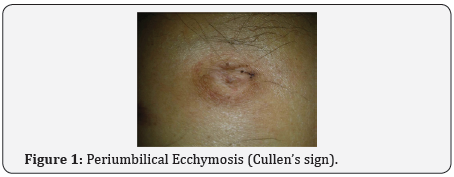Cullen’s Sign in Acute Hemorrhagic Pancreatitis
ADVANCED RESEARCH IN GASTROENTEROLOGY &HEPATOLOGY JUNIPER PUBLISHERS
Authored by Ali Aamar
Clinical Image
A 66-year-old male with a history of alcohol abuse
presented with epigastric pain for two days. He had been drinking
heavily for one year. The serum lipase level was markedly elevated
(10,219 IntUnit/L; Normal range 23 to 300 IntUnit/L). The physical
examination showed periumbilical ecchymosis (Cullen’s sign, Figure A).
The CT abdomen suggested diffuse pattern of edema in pancreas with small
areas of increased attenuation, consistent with acute hemorrhagic
pancreatitis. Patient had a prolonged hospital stay complicated by
bilateral exudative pleural effusions secondary to acute pancreatitis.
Cullen’s sign (ecchymosis of the periumbilical region) and Grey Turner’s
sign (ecchymosis of the flank) suggests retroperitoneal hemorrhage
associated with severe pancreatic necrosis and high mortality. Early
recognition of these physical examination findings can help
appropriately triage high risk patients (Figure 1).

Keywords: Hemorrhagic pancreatitis; Cullen’s sign
To Know More About Advanced Research in Gastroenterology &
Hepatology Journal
click on:
https://juniperpublishers.com/argh/index.php
https://juniperpublishers.com/argh/index.php




Comments
Post a Comment